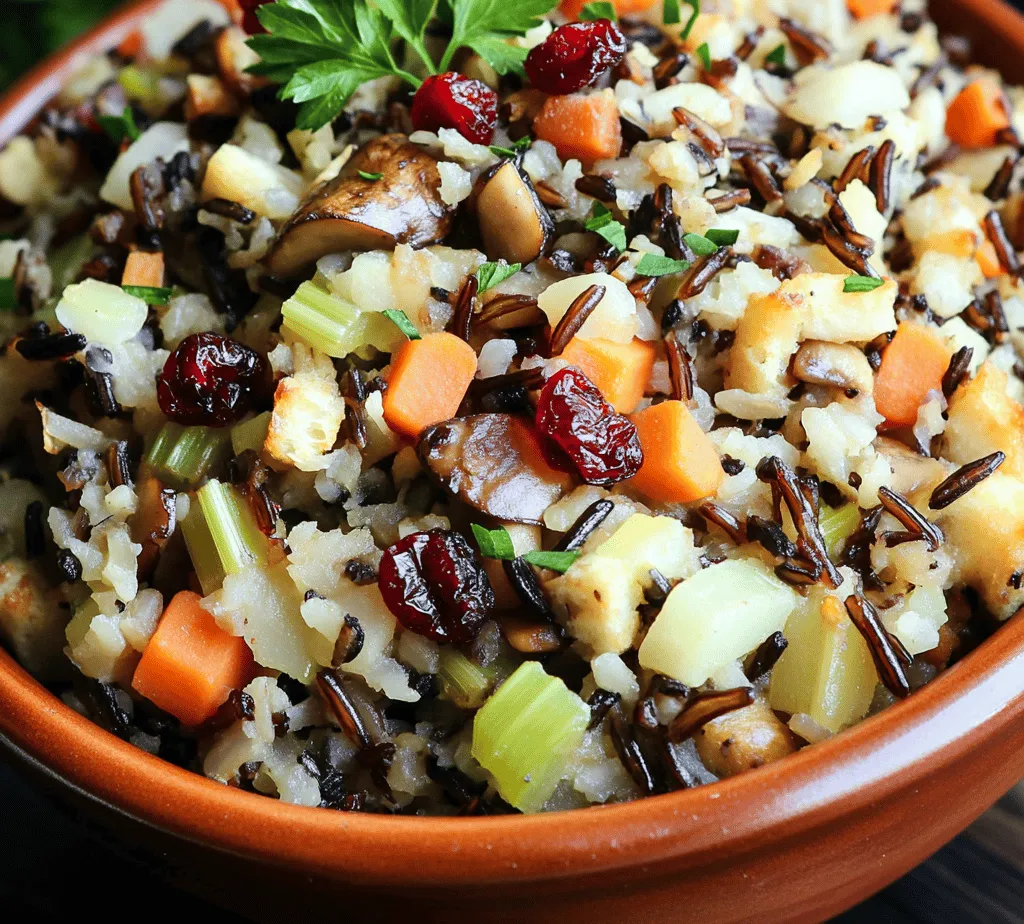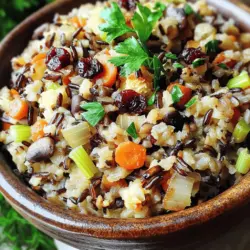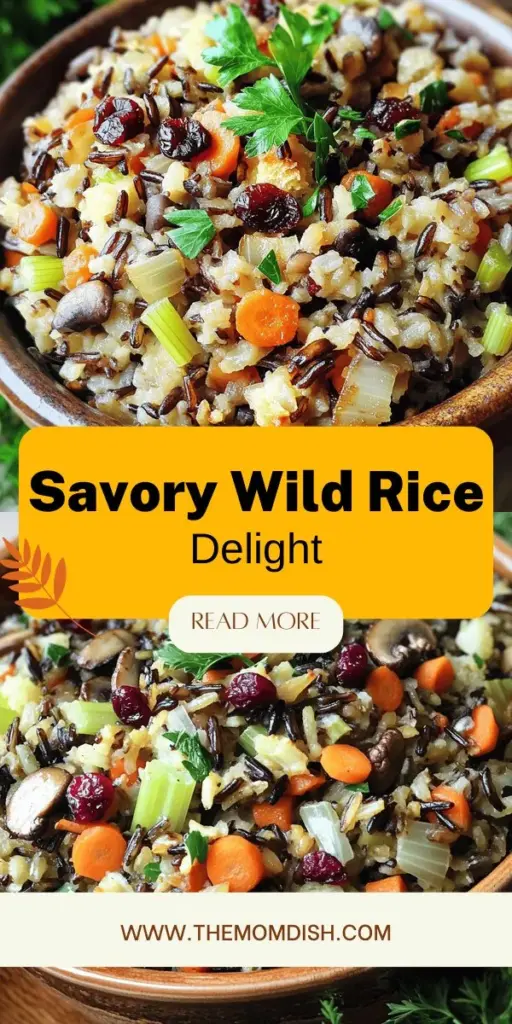Introduction
Savory wild rice stuffing is more than just a dish; it’s a celebration of flavors, traditions, and the bounty of nature. Rooted in various culinary traditions, particularly among Native American cultures, wild rice has been a cherished staple for centuries. This unique grain, which is technically not rice but a seed from the grass family, elevates any stuffing recipe into a gourmet experience. Whether served as a side dish during festive gatherings or as a main course for a cozy family dinner, wild rice stuffing is versatile enough to adapt to any occasion.
The beauty of wild rice stuffing lies in its adaptability. It can take center stage on a dinner table or complement a roasted turkey, a succulent pork loin, or a hearty vegetable dish. Its earthy flavors and chewy texture provide a satisfying contrast to the more common white or brown rice stuffings, making it an appealing choice for those looking to explore new culinary horizons.
In addition to its delightful taste, wild rice is packed with health benefits. Unlike its more common counterparts, wild rice is rich in antioxidants, fiber, and protein, making it a nutritious option for anyone seeking a wholesome meal. Coupled with fresh vegetables and herbs, this stuffing becomes a nutrient-dense side that not only tantalizes the taste buds but also nourishes the body.
Understanding Wild Rice
To truly appreciate savory wild rice stuffing, it’s essential to understand the grain at its core. Wild rice, or Zizania, is indigenous to North America and has been harvested by Native Americans for thousands of years. Traditionally found in shallow waters of lakes and rivers, wild rice is harvested in the fall, where it is hand-picked from canoe boats. This labor-intensive process contributes to its unique character and delicate flavor.
Nutritionally, wild rice stands out among other grains. It contains more protein than brown rice and is significantly higher in fiber, which aids digestion. With a lower glycemic index, wild rice is also a fantastic option for those monitoring their blood sugar levels. Each serving of wild rice provides essential vitamins and minerals, including B vitamins, zinc, and magnesium.
When it comes to flavor, wild rice offers a nutty and earthy profile that pairs beautifully with a wide range of ingredients. Its chewy texture adds a delightful contrast to softer components in the stuffing, such as sautéed vegetables or dried fruits. Additionally, wild rice can be blended with other grains, such as brown rice or quinoa, to create a more complex flavor experience. Each type of rice blend brings its own unique characteristics, enhancing the overall depth of the dish.
Ingredients Breakdown
Creating the perfect savory wild rice stuffing begins with selecting high-quality ingredients. Each component plays a significant role in the overall flavor and nutritional value of the dish.
Wild Rice
The star ingredient, wild rice, should be chosen carefully. Opt for whole grain wild rice rather than pre-packaged mixes that may contain additives or preservatives. Look for varieties that are sustainably sourced to support environmental practices.
Fresh Vegetables
Fresh vegetables are crucial for adding flavor and texture to the stuffing. Common choices include:
– Onions: They provide a savory base, adding sweetness and depth when sautéed.
– Celery: Offers a crisp texture and a subtle earthiness that complements the wild rice.
– Carrots: They add a natural sweetness and vibrant color to the stuffing.
Herbs and Spices
Herbs and spices are essential for enhancing the flavor profile of the dish. Consider including:
– Thyme: A classic herb in stuffing, thyme lends a warm, earthy flavor that pairs well with wild rice.
– Sage: Its slightly peppery and aromatic qualities add depth and complexity.
– Salt and Pepper: Essential for seasoning and bringing out the natural flavors of each ingredient.
Dried Fruits and Nuts
For a touch of sweetness and texture, consider adding dried cranberries or cherries. These fruits infuse the stuffing with a pleasant tartness that balances the savory elements. Nuts, such as pecans or walnuts, can also be included for added crunch and richness.
Broth
Using vegetable or chicken broth instead of water for cooking the wild rice enhances the overall flavor. The broth infuses the rice with savory notes, making the stuffing even more delicious.
Ingredient Substitutes
For those with dietary restrictions, wild rice stuffing can be easily adapted. For a gluten-free option, ensure that all ingredients, including broth and any added condiments, are certified gluten-free. If there are nut allergies, feel free to omit nuts or replace them with seeds, such as sunflower seeds, for added crunch without the risk.
Preparation Steps
Now that we have a solid understanding of the ingredients, it’s time to delve into the preparation of this savory wild rice stuffing. Proper cooking techniques are essential for achieving the best flavor and texture.
Cooking the Wild Rice
1. Rinse the Rice: Start by rinsing the wild rice under cold water to remove any debris or impurities. This step is crucial for ensuring that the rice cooks evenly and absorbs flavors effectively.
2. Cook the Rice: In a medium saucepan, combine 1 cup of rinsed wild rice with 3 cups of vegetable or chicken broth. Bring the mixture to a boil, then reduce the heat to low and cover. Allow the rice to simmer for about 45-50 minutes, or until the grains are tender and have split open. Remove from heat and let it sit covered for an additional 10 minutes to steam. Fluff with a fork before using.
Sautéing the Vegetables
While the wild rice is cooking, it’s the perfect time to prepare the vegetables. Sautéing is an essential technique that enhances the flavor and texture of the ingredients.
1. Heat Oil: In a large skillet, heat a tablespoon of olive oil or butter over medium heat.
2. Add Aromatics: Start by adding diced onions and sauté for about 3-4 minutes until they become translucent.
3. Incorporate Other Vegetables: Next, add diced celery and carrots to the pan. Sauté for an additional 5-7 minutes until the vegetables are tender. Stir occasionally to prevent burning.
4. Season: Sprinkle in salt, pepper, thyme, and sage during the last minute of cooking to release their aromatic oils and deepen the flavors.
5. Combine with Rice: Once the wild rice is cooked, add it to the skillet with the sautéed vegetables. Gently mix to combine and allow the flavors to meld together over low heat for a few minutes.
By following these steps, you will have a fragrant and flavorful base for your savory wild rice stuffing, ready to be enhanced with additional ingredients and served as a delightful accompaniment to your meals.
As we continue to explore the intricate flavor combinations and the final steps of crafting this dish, it becomes evident that savory wild rice stuffing is not merely a recipe; it is an expression of culinary creativity, health, and tradition.

The Role of Nuts in Savory Wild Rice Stuffing
When it comes to enhancing the flavor and texture of savory wild rice stuffing, the addition of nuts such as pecans or walnuts plays a pivotal role. These crunchy elements not only add a delightful textural contrast but also introduce a rich, earthy flavor that complements the inherent nuttiness of wild rice. Nuts are packed with healthy fats, protein, and essential nutrients, making them a fantastic addition to this dish. Their natural oils contribute to a richer mouthfeel and enhance the overall taste experience, making each bite more satisfying.
Incorporating nuts into your stuffing is simple: roughly chop them and toast them lightly in a skillet before mixing them into the rice and vegetable mixture. Toasting enhances their flavor and brings out their aroma, creating a warm and inviting stuffing that is perfect for any occasion.
Cooking Techniques
The importance of sautéing vegetables before combining them with the rice cannot be overstated. Sautéing helps to draw out the natural sugars in the vegetables, leading to caramelization that adds depth and richness to the stuffing. Start by heating a bit of olive oil or butter in a skillet over medium heat, then add your diced onions, carrots, and celery. Cook them until they become soft and translucent, usually around 5-7 minutes. This technique not only builds a flavor base but also ensures that your vegetables are tender and flavorful, providing a perfect balance to the chewy wild rice.
Cooking wild rice correctly is essential for achieving the perfect texture. Wild rice generally requires a longer cooking time than white or brown rice, as it is a whole grain. Begin by rinsing the rice under cold water to remove any debris. Then, in a large saucepan, combine 1 cup of wild rice with 3 cups of water or broth, a pinch of salt, and bring it to a boil. Reduce the heat to low, cover, and let it simmer for about 45-60 minutes, or until the grains are tender and the outer hulls have split open. For the best results, it’s advisable to let the cooked rice sit, covered, for an additional 10-15 minutes to absorb any remaining moisture.
Once the rice is cooked, allow it to cool slightly before mixing it with the sautéed vegetables and nuts. This will prevent the stuffing from becoming mushy and ensures that every ingredient retains its distinct flavor.
Serving Suggestions
Savory wild rice stuffing can be enjoyed in various ways. For a wholesome meal, serve it as a standalone dish, allowing the flavors to shine. Alternatively, consider using it as a stuffing for roasted vegetables such as bell peppers, acorn squash, or zucchini. Hollow out the vegetables and fill them generously with the wild rice stuffing, then roast until the vegetables are tender. This not only elevates the dish but also adds a colorful presentation to your table.
To enhance the visual appeal, consider garnishing your dish with fresh herbs, such as parsley or chives, just before serving. A sprinkle of freshly cracked black pepper can add a touch of sophistication, while a drizzle of balsamic glaze can provide a beautiful contrast against the earthy tones of the stuffing.
When it comes to pairing, this stuffing pairs exceptionally well with a variety of proteins. Consider serving it alongside roasted chicken, turkey, or baked fish for a balanced meal. For a plant-based option, it complements grilled tofu or tempeh beautifully. Additionally, serving it with a side of simple steamed vegetables or a fresh salad can round out your meal perfectly.
Nutritional Analysis
A serving of savory wild rice stuffing offers a well-rounded nutritional profile. On average, a cup of this stuffing contains approximately 250-300 calories, depending on the specific ingredients used and the amount of nuts and oil added. The dish is rich in dietary fiber, thanks to the wild rice and vegetables, which can help promote digestive health and keep you feeling full longer.
Wild rice is a fantastic source of complex carbohydrates, providing sustained energy without causing spikes in blood sugar levels. The nuts contribute healthy fats and protein, while the vegetables add essential vitamins and minerals. This dish is suitable for various dietary plans, including vegetarian, vegan, and gluten-free diets, making it an excellent choice for gatherings with diverse dietary preferences.
The balance of carbohydrates, protein, and healthy fats in this stuffing also makes it a satisfying option for those looking to maintain a healthy lifestyle. Whether you’re preparing it for a festive occasion or as a comforting weeknight meal, this dish can easily fit into a balanced diet.
Cultural Significance
Wild rice stuffing is not just a delicious dish but also carries cultural significance in various cuisines, especially during festive occasions. Native to North America, wild rice has been a staple in Indigenous communities for centuries. Its sustainable harvesting practices, often done by hand in canoes, have deep cultural roots and signify respect for nature and the environment.
In many families, stuffing dishes have become a Thanksgiving tradition, symbolizing gratitude for the harvest and the importance of coming together. Stories are often shared around the table, with family members recounting their favorite memories associated with preparing and enjoying stuffing dishes. This communal aspect of cooking and sharing food fosters a sense of connection and belonging.
As wild rice gained popularity in contemporary cooking, it has found its way into various cultural cuisines, often adapted to fit local flavors and preferences. From savory stuffing to hearty soups, wild rice continues to be celebrated for its unique texture and nutty flavor.
Conclusion
Savory wild rice stuffing is a versatile dish brimming with flavor, texture, and nutritional benefits. Whether served as a standalone dish, used to stuff vegetables, or paired with a protein, this stuffing can elevate any meal to new heights. The combination of wild rice, sautéed vegetables, crunchy nuts, and aromatic herbs creates a delightful harmony that pleases the palate.
The joy of creating and sharing a homemade wild rice stuffing goes beyond mere sustenance; it connects us to our traditions and loved ones. As you explore this recipe, don’t hesitate to experiment with variations based on your personal tastes and seasonal ingredients. Whether it’s adding cranberries for a touch of sweetness or incorporating different herbs for added depth, the possibilities are endless.
So gather your ingredients, invite your loved ones, and immerse yourself in the delightful experience of preparing and enjoying this savory wild rice stuffing. It’s a dish that embodies the spirit of togetherness, nourishment, and celebration.



